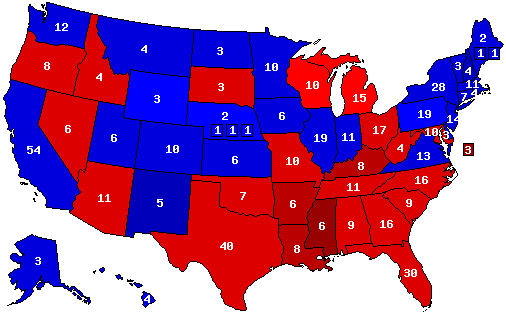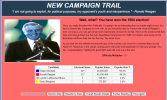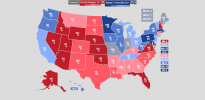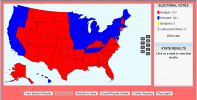You are using an out of date browser. It may not display this or other websites correctly.
You should upgrade or use an alternative browser.
You should upgrade or use an alternative browser.
Alternate Electoral Maps III
- Thread starter killertahu22
- Start date
the good endingMario Cuomo Runs in the 1988 Election with Dale Bumpers as his Running Mate:
View attachment 829254
Mario Cuomo Runs in the 1988 Election with Dale Bumpers as his Running Mate:
View attachment 829254
Part 2:
Note: President Cuomo would be assassinated on November 19th before January 20th and Vice President Bumpers would ascend to the presidency.
Last edited:
Following on from this post, elections to each of Armenia's provinces took place at the same time. This is the election results for the provincial assembly of Pontus.


The minority assembly government led by the Civic Alliance - which included other right-of-centre parties - was succeeded by a left-wing government of the Social Democratic Party and the SHTH, a party that chiefly caters to Armenia's Turkish population.


The minority assembly government led by the Civic Alliance - which included other right-of-centre parties - was succeeded by a left-wing government of the Social Democratic Party and the SHTH, a party that chiefly caters to Armenia's Turkish population.
Last edited:
Jesse Ventura Runs in 2008 as an Independent:

Note: Barack Obama Wins the Contingent Election.
Note: Barack Obama Wins the Contingent Election.
Is that......a Republican winning without Ohio.......?The Spirit of 1976
Former Governor Ronald Reagan (CA) / Congressman Guy Vander Jagt (MI)
def. President Edmund Muskie (ME) / Vice President Henry M. Jackson (WA)
View attachment 831876
Just my average boring Weimar map. Wanted to wank the social democrats and especially the socialist. Maybe after a long reign of Zentrum/DVP/DStP (maybe a successor party) and slowly losing popularity. I would imagine the DNVP slowly reforming itself to become more like a non catholic Zentrum party, maybe trying to win over the DVP against Zentrum, or Zentrum and DNVP working together when having to deal with the SPD.
Also, the KPD slowly faded away. With no horros of nazism and thus more focus on communism, especially Stalinism that the party started to hard press embrace, the partly lost popularity with communist and leftist who search for an alternative to the SPD. So instead the Socialist Workers' Party of Germany (SAPD) replaced the KPD. Probably most joining the SAPD and the hard core stalinist remaining in the KPD.
More specifically I just wanted to play with the colours. So that the Communist/Socialist are represented in red instead of magenta like in OTL. Also christian conservatives (specifically catholics) are represented in blue here instead of black. That spot goes to the non-catholic conservatives/nationalists.

Also, the KPD slowly faded away. With no horros of nazism and thus more focus on communism, especially Stalinism that the party started to hard press embrace, the partly lost popularity with communist and leftist who search for an alternative to the SPD. So instead the Socialist Workers' Party of Germany (SAPD) replaced the KPD. Probably most joining the SAPD and the hard core stalinist remaining in the KPD.
More specifically I just wanted to play with the colours. So that the Communist/Socialist are represented in red instead of magenta like in OTL. Also christian conservatives (specifically catholics) are represented in blue here instead of black. That spot goes to the non-catholic conservatives/nationalists.
It had to be done.

Nolan/Murphy (Oppenheimer): 271 EVs
Gerwig/Robbie (Barbie): 267 EVs
(Just ignore the fact the running mates and possibly Nolan would be ineligible, of course.)
Nolan/Murphy (Oppenheimer): 271 EVs
Gerwig/Robbie (Barbie): 267 EVs
(Just ignore the fact the running mates and possibly Nolan would be ineligible, of course.)
Please tell me this was done with actual box office receipts.It had to be done.

Nolan/Murphy (Oppenheimer): 271 EVs
Gerwig/Robbie (Barbie): 267 EVs
(Just ignore the fact the running mates and possibly Nolan would be ineligible, of course.)
left to right, top to bottom:
1912: Theodore Roosevelt/Hiram Johnson (Progressive) def. Champ Clark/George E. Chamberlain (Democratic), William Howard Taft/Nicholas Murray Butler (Republican)
1916: William Jennings Bryan/Robert La Follette (anti-Roosevelt fusion, no standardized party label) def. Theodore Roosevelt/A. Mitchell Palmer (Progressive)
1920: Eugene V. Debs (Socialist endorsed after election but before Electoral College by Farmer-Labor) def. Josephus Daniels (Democratic), Herbert Hoover (Republican),
1924: William Haywood/John Reed (Socialist) def. Henry Ford/James D. Phelan (Democratic), William Allen White/Amos Pinchot (Republican)
1928: Samuel Seabury/Thomas J. Walsh (Union) def. J. Mahlon Barnes/Jasper McLevy (Socialist)
1931 (special): Earl Browder/Jasper McLevy (Socialist) def. William Randolph Hearst/James E. Watson (National Unity), Winston Churchill/Hiram Johnson (Republican)
Last edited:
Seabury had to resign because of a nasty strike.Why is there a 1931 election?
Why would that not make Walsh president?Seabury had to resign because of a nasty strike.
Why is there a 1931 election?
Seabury had to resign because of a nasty strike.
Seabury and Walsh made a deal with the Socialist Party to resign in order to end the 1931 General Strike; under the terms of the 1926 Presidential Succession Act, a vacancy in the presidency automatically triggered a special election. Seabury agreed to resign in part because of his fear that continued civil unrest could only end in a dictatorial state of exception by one side or the other, in part because he was increasingly disillusioned with his own political supporters, and in part because he believed he had accomplished what he had been elected to accomplish; Walsh, for his part, was suffering from heart problems and did not want to be the third President in a decade to die in office.Why would that not make Walsh president?
Guess who finally managed to come up with an update for the China TL? Here's the most recent provincial election in Gansu.
*

Gansu Province’s provincial legislature was one of the last to have its first election, which was held in July 1992; only Jiangsu and (due to being formed after all the other provinces and cities) Chongqing had their first elections later. It’s notable for its slightly unusual mixed electoral system, with half the 200 seats elected from FPTP districts (which, like many at this level of government in China, are malapportioned in a lot of areas) and the other half elected from two PR lists. One list, known as the ‘prefecture list’, elects 80 members distributed between Gansu’s prefectures (aside from Jiayuguan and Jinchang, which are counted with Jiuquan and Zhangye), while the other, the ‘province list’, elects 20 more members using the whole province as a single constituency with votes tallied from all the prefectures.
The longtime warlord of Gansu, Ma Hongkui, contributed significantly to its socio-political culture- violently anti-communist and Islamist, his ‘Ma clique’ had held an iron grip on northwestern China from the mid-19th century more or less until democratization, and he represented the clique’s most conservative inclinations in contrast to the relative liberalism of Ma Bufang in neighbouring Qinghai. While the Han and Muslim population of Gansu admired Ma for his aggressively anti-corruption and anti-insurgent governance, allowing him to proclaim Gansu ‘the cleanest province in China’ under his rule, he also had a very high military draft (going up to age 55) and brutally repressed dissidence.
Perhaps unsurprisingly, his regime met with violent guerilla opposition, most prominently in the form of Zhang Guotao, a former disciple of Mao Zedong who led the remnants of the Chinese Communist forces after their defeat and Mao’s death in October 1934. Even though the bulk of Zhao’s original forces were annihilated in 1936 by the Ma clique when crossing the Yellow River, Zhao went underground and resurfaced in the 1940s, leading opposition to the nationalist movements and the Ma clique for most of the rest of his life. However, his ineffectual leadership of the Communist Party has been blamed for its failure to secure dominance over China since democratization came into force.
The other big force opposing Ma was the Tibetan regions of southwestern Gansu, which were both culturally and geographically close to Qinghai. Their Buddhist faith was frequently repressed by Ma’s government in favour of state-sponsored Islam, to the point that Tibetan Buddhists from neighbouring provinces joined their fellows in protests in Gansu, culminating in 1967 with the Hezuo Massacre where 106 Buddhist protestors were murdered and Ma was forced to resign in disgrace.
Ma Hongkui’s son Ma Dunjing succeeded him and introduced an amnesty for Gansu Buddhists, proceeding to slowly moderated his stance towards an ideology closer to Islamic democracy while embracing economic liberalisation that made the province’s cities richer and its countryside infamously poor. Considering this emerging deprivation and the aggressive repression of the Ma clique, Gansu was a favourable region for the Progressives, with Liu Xiaobo winning it easily in the 1990 presidential election and the party’s provincial leader Liu Wenshing leading an energetic campaign where he urged its newly enfranchised voters to ‘end 130 years of Ma rule’ in the 1992 provincial election, which they did with an absolute majority which has never been repeated by either party.
The Kuomintang hasn’t been as toothless in Gansu as it has been in provinces like Qinghai, Hebei or Tibet, though. Conservative Islamic values remain prominent in the province, and the Progressives’ general social liberalism has made them a bit of a harder sell compared to regions of China where the Muslim population is more secular (which notably showed when the Kuomintang’s Wang Yang defeated Progressive Jung Chang there in his 2005 presidential landslide). The Kuomintang have also managed to largely avoid bleeding votes to the Loyalists on that front by maintaining a strongly conservative stance, and the legacy of Zhao Guotao means the Communists perform better in Gansu than a lot of other left-leaning provinces.
The 2020 election was held during the onset of the meteoric rise of Jiang Jielian, in early August of that year, and the Covid policies of Governor Long Kehai (who had been among the first to adopt generous furlough support and subsidies for workers) worked to his advantage. Despite his Kuomintang opponent, Liu Jun, fighting a campaign where he claimed the Progressives would ‘force a secular liberal agenda’ on the people of Gansu, Long used populist critiques of Liu’s banker connections and wealth to bolster his support.
This worked a treat, and the Progressives came the closest they have since 1992 to winning an absolute majority of seats. Notably, they formed an alliance with the Greens in the province, ostensibly motivated by a shared interest in environmental protection but widely and correctly observed to be a move meant to give the Progressives a workable majority once Jiang’s socially liberalising policies came to the forefront of politics. This worked well to help block a publicly-proposed legislative bill to define marriage as between one woman and one man (though the bill floundered even before this when it became clear it would limit the rights of Muslims to polygamy) and to ensure Long made his party’s delegates to the National Congress stand behind Jiang in his electoral reforms. With the next election due next summer, Long looks fairly likely to secure a third term without much trouble, cementing Gansu’s status as a Progressive bastion.
Chinese provincial/city council election maps
Beijing
Guangdong
Chongqing
Shaanxi
Inner Mongolia
Shanxi
Sichuan
Tibet
Qinghai
Xinjiang/East Turkestan referendum
Fujian
Hubei
Shanghai (2015)
Hainan
Jiangsu
Jilin
Shanghai (2021)
Guangxi
*
Gansu Province’s provincial legislature was one of the last to have its first election, which was held in July 1992; only Jiangsu and (due to being formed after all the other provinces and cities) Chongqing had their first elections later. It’s notable for its slightly unusual mixed electoral system, with half the 200 seats elected from FPTP districts (which, like many at this level of government in China, are malapportioned in a lot of areas) and the other half elected from two PR lists. One list, known as the ‘prefecture list’, elects 80 members distributed between Gansu’s prefectures (aside from Jiayuguan and Jinchang, which are counted with Jiuquan and Zhangye), while the other, the ‘province list’, elects 20 more members using the whole province as a single constituency with votes tallied from all the prefectures.
The longtime warlord of Gansu, Ma Hongkui, contributed significantly to its socio-political culture- violently anti-communist and Islamist, his ‘Ma clique’ had held an iron grip on northwestern China from the mid-19th century more or less until democratization, and he represented the clique’s most conservative inclinations in contrast to the relative liberalism of Ma Bufang in neighbouring Qinghai. While the Han and Muslim population of Gansu admired Ma for his aggressively anti-corruption and anti-insurgent governance, allowing him to proclaim Gansu ‘the cleanest province in China’ under his rule, he also had a very high military draft (going up to age 55) and brutally repressed dissidence.
Perhaps unsurprisingly, his regime met with violent guerilla opposition, most prominently in the form of Zhang Guotao, a former disciple of Mao Zedong who led the remnants of the Chinese Communist forces after their defeat and Mao’s death in October 1934. Even though the bulk of Zhao’s original forces were annihilated in 1936 by the Ma clique when crossing the Yellow River, Zhao went underground and resurfaced in the 1940s, leading opposition to the nationalist movements and the Ma clique for most of the rest of his life. However, his ineffectual leadership of the Communist Party has been blamed for its failure to secure dominance over China since democratization came into force.
The other big force opposing Ma was the Tibetan regions of southwestern Gansu, which were both culturally and geographically close to Qinghai. Their Buddhist faith was frequently repressed by Ma’s government in favour of state-sponsored Islam, to the point that Tibetan Buddhists from neighbouring provinces joined their fellows in protests in Gansu, culminating in 1967 with the Hezuo Massacre where 106 Buddhist protestors were murdered and Ma was forced to resign in disgrace.
Ma Hongkui’s son Ma Dunjing succeeded him and introduced an amnesty for Gansu Buddhists, proceeding to slowly moderated his stance towards an ideology closer to Islamic democracy while embracing economic liberalisation that made the province’s cities richer and its countryside infamously poor. Considering this emerging deprivation and the aggressive repression of the Ma clique, Gansu was a favourable region for the Progressives, with Liu Xiaobo winning it easily in the 1990 presidential election and the party’s provincial leader Liu Wenshing leading an energetic campaign where he urged its newly enfranchised voters to ‘end 130 years of Ma rule’ in the 1992 provincial election, which they did with an absolute majority which has never been repeated by either party.
The Kuomintang hasn’t been as toothless in Gansu as it has been in provinces like Qinghai, Hebei or Tibet, though. Conservative Islamic values remain prominent in the province, and the Progressives’ general social liberalism has made them a bit of a harder sell compared to regions of China where the Muslim population is more secular (which notably showed when the Kuomintang’s Wang Yang defeated Progressive Jung Chang there in his 2005 presidential landslide). The Kuomintang have also managed to largely avoid bleeding votes to the Loyalists on that front by maintaining a strongly conservative stance, and the legacy of Zhao Guotao means the Communists perform better in Gansu than a lot of other left-leaning provinces.
The 2020 election was held during the onset of the meteoric rise of Jiang Jielian, in early August of that year, and the Covid policies of Governor Long Kehai (who had been among the first to adopt generous furlough support and subsidies for workers) worked to his advantage. Despite his Kuomintang opponent, Liu Jun, fighting a campaign where he claimed the Progressives would ‘force a secular liberal agenda’ on the people of Gansu, Long used populist critiques of Liu’s banker connections and wealth to bolster his support.
This worked a treat, and the Progressives came the closest they have since 1992 to winning an absolute majority of seats. Notably, they formed an alliance with the Greens in the province, ostensibly motivated by a shared interest in environmental protection but widely and correctly observed to be a move meant to give the Progressives a workable majority once Jiang’s socially liberalising policies came to the forefront of politics. This worked well to help block a publicly-proposed legislative bill to define marriage as between one woman and one man (though the bill floundered even before this when it became clear it would limit the rights of Muslims to polygamy) and to ensure Long made his party’s delegates to the National Congress stand behind Jiang in his electoral reforms. With the next election due next summer, Long looks fairly likely to secure a third term without much trouble, cementing Gansu’s status as a Progressive bastion.
Chinese provincial/city council election maps
Beijing
Guangdong
Chongqing
Shaanxi
Inner Mongolia
Shanxi
Sichuan
Tibet
Qinghai
Xinjiang/East Turkestan referendum
Fujian
Hubei
Shanghai (2015)
Hainan
Jiangsu
Jilin
Shanghai (2021)
Guangxi
Revised the 1796 presidential election for my "Mad Anthony Wayne" TL. The election will take place within the next few updates, so figured I'd post it here and get some feedback. My only goal is to have no candidate reach a majority, and for Anthony Wayne to be in the top 5 candidates by number of electoral votes. Wayne engages in holding meetings with various potential electors in Pennsylvania and Maryland to convince them to use one of their two votes on him.

The state of the states, 2022:View attachment 848299
left to right, top to bottom:
1912: Theodore Roosevelt/Hiram Johnson (Progressive) def. Champ Clark/George E. Chamberlain (Democratic), William Howard Taft/Nicholas Murray Butler (Republican)
1916: William Jennings Bryan/Robert La Follette (anti-Roosevelt fusion, no standardized party label) def. Theodore Roosevelt/A. Mitchell Palmer (Progressive)
1920: Eugene V. Debs (Socialist endorsed after election but before Electoral College by Farmer-Labor) def. Josephus Daniels (Democratic), Herbert Hoover (Republican),Robert La Follette (Farmer-Labor); William Gibbs McAdoo (Democratic) elected Vice President by Senate
1924: William Haywood/John Reed (Socialist) def. Henry Ford/James D. Phelan (Democratic), William Allen White/Amos Pinchot (Republican)
1928: Samuel Seabury/Thomas J. Walsh (Union) def. J. Mahlon Barnes/Jasper McLevy (Socialist)
1931 (special): Earl Browder/Jasper McLevy (Socialist) def. William Randolph Hearst/James E. Watson (National Unity), Winston Churchill/Hiram Johnson (Republican)
| Party | Sole governing political group | Leads coalition | Part of coalition | Formally part of SDPA? | Socialist? | Pro-2010? | Particularist? |
|---|---|---|---|---|---|---|---|
| Social Democratic Party of America - Majority Caucus | thirty-one states | no states | two states | yes | yes | neutral | no |
| Council for the Public Interest | five states | no states | one state | yes | yes | no | no |
| Young Americans for Socialism | three states | no states | two states | yes | yes | yes | no |
| The Everybody Movement | two states | one state | no states | no | no | yes | not formally (de facto tech industry in Kan./Mo.) |
| People's Democratic Party | one state | one state | one state | no | big tent | yes | yes, rural Southerners |
| Liberation! | one state | one state | no states | no | yes | neutral | yes, Afro-Americans |
| Farmer-Labor Party | one state | no states | one state | no | yes | yes | yes, farmers (hemp farmers in Ky.) |
| League for Industrial Democracy | one state | no states | no states | no | yes | yes | no |
| Center for New Liberalism | no states | one state | one state | no | no | yes | no |
| Spirit of 2010 | no states | one state | no states | no | big tent | yes | no |
Share:


